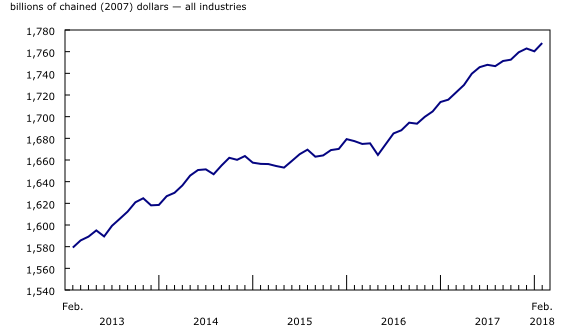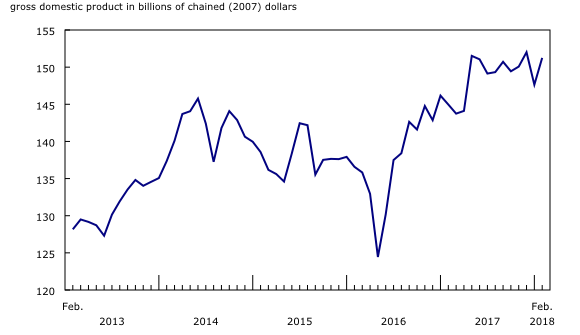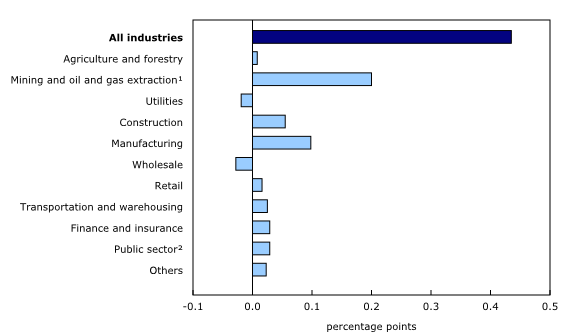Gross domestic product by industry, February 2018
Archived Content
Information identified as archived is provided for reference, research or recordkeeping purposes. It is not subject to the Government of Canada Web Standards and has not been altered or updated since it was archived. Please "contact us" to request a format other than those available.
Released: 2018-05-01
February 2018
0.4% 
(monthly change)
After a slight decline in January, real gross domestic product rose 0.4% in February, as 15 of 20 industrial sectors increased. The growth was led by a rebound in the mining and oil and gas extraction sector.
The output of goods-producing industries grew 1.2% as manufacturing and construction rose in addition to the rebound in mining and oil and gas extraction.
Services-producing industries edged up 0.1% as increases in most sectors more than offset declines in wholesale trade and in the real estate and rental and leasing sector.
Mining, quarrying and oil and gas extraction leads the growth
The mining, quarrying and oil and gas extraction sector expanded 2.4% in February.
Conventional oil and gas extraction rose 2.9% from increased crude petroleum and natural gas extraction. Non-conventional oil extraction was up 3.0%, offsetting some of January's decline, as production began returning to normal levels as some facilities experienced a number of issues affecting their capacity in January.
Mining excluding oil and gas grew 1.9% following four months of decline. Non-metallic mineral mining rose 6.3%, mainly as a result of increased potash production to supply export markets outside North America. Metal ore mining declined (-0.9%) for the fourth month in a row, as growth in iron ore (+8.2%) and gold and silver ore (+1.4%) mining was more than offset by a sixth consecutive decline in copper, nickel, lead and zinc mining (-6.2%) and lower other metal ore mining (-3.9%).
Support activities for mining and oil and gas extraction declined 0.9% as a result of lower rigging services in February.
Manufacturing up from durables
The manufacturing sector rose 1.0% in February as durable manufacturing was up 1.8%, while non-durable manufacturing was essentially unchanged.
Durable manufacturing (+1.8%) was up for the third time in four months on broad-based growth as 8 of 10 subsectors grew. Transportation equipment led the growth, expanding 2.7%, as motor vehicle (+4.2%) and motor vehicle parts (+3.4%) manufacturing began returning to normal production following atypical plant shutdowns in January. Aerospace product and parts manufacturing rose 1.2% as exports of aircrafts contributed to growth. Fabricated metal products manufacturing grew 4.4% as the majority of industry groups expanded.
Non-durable manufacturing was essentially unchanged in February. Chemical manufacturing was down 1.6% as there were unscheduled plant shutdowns stretching from late January until mid-February. This decline was offset by increases in other subsectors, led by paper manufacturing (+1.9%) and petroleum and coal products (+0.8%), which rose for the first time following three consecutive monthly declines.
Construction grows
The construction sector was up 0.7% as activity in the majority of subsectors increased. Residential construction grew 1.3% from increases in row, apartment-type dwellings, and home alterations and improvements. Non-residential construction expanded 0.6% as industrial, public and commercial construction increased. Repair construction rose 1.6%, while engineering and other construction activities declined 0.2%.
Finance and insurance up
The finance and insurance sector rose 0.4% in February. Financial investment services, funds and other financial vehicles were up 2.0% from increased activity in bond and foreign securities markets. Depository credit intermediation and monetary authorities grew 0.2%, while insurance carriers and related activities edged up 0.1%.
Most subsectors in transportation and warehousing show gains
Transportation and warehousing rose 0.5% in February as five of nine subsectors increased. Support activities for transportation (+1.5%), truck transportation (+1.0%) and air transportation (+0.9%) led the growth.
Pipeline transportation decreased 1.0%. Crude oil and other pipeline transportation increased 0.2%, as exports to the United States increased while domestic deliveries declined. Pipeline transportation of natural gas decreased 2.2% as exports and imports of natural gas declined.
Rail transportation edged down 0.1% after a 3.4% decline in January, as lower carloadings of grains and fertilizers were mainly offset by increased rail movement of other goods such as minerals and manufactured goods.
First back-to-back declines in the real estate and rental and leasing sector since the summer of 2010
Following a 0.5% decline in January, real estate and rental and leasing was down 0.2% in February, the first back-to-back declines since the summer of 2010. The output of offices of real estate agents and brokers fell 7.9% in February after a 12.9% drop in January. Home resale activity declined in the majority of Canadian markets in the aftermath of the implementation of new mortgage lending rules in January 2018, including stress-testing for uninsured mortgages.
Wholesale trade declines while retail trade grows
Wholesale trade declined 0.5% in February, continuing its sequence of offsetting increases and decreases since November 2017. Seven of nine subsectors declined. Contributing most to the decline were miscellaneous wholesaling (-2.2%) on account of lower agricultural supplies wholesaling, and wholesalers of farm products (-4.9%) as a result of lower exports of wheat, canola, and other farming and intermediate food products. Motor vehicle and parts wholesaling (-2.3%) declined for the third consecutive month.
The retail trade sector grew 0.3% in February after three consecutive monthly declines. Increases in building material and garden equipment and supplies (+3.1%), general merchandise stores (+2.6%), motor vehicle and parts dealers (+0.7%) and health and personal care stores (+0.2%) more than offset declines in other subsectors.
Other industries
Professional, scientific and technical services were up 0.6% in February, the third increase in four months, with gains in most industry groups.
The public sector edged up 0.1%, with all three components (education, health care and public administration) showing increases.
Information and cultural industries rose 0.4%, partly as a result of increased advertising revenue earned by the radio and television broadcasting industry largely related to the airing of the 2018 Winter Olympics.
Agriculture, forestry, fishing and hunting increased 0.5%.
Accommodation and food services was unchanged as growth of 0.2% in food services and drinking places was offset by a 0.6% decline in accommodation services.
Utilities declined 0.9%. Electric power generation, transmission and distribution decreased 1.2%, as an unseasonably warm February in Central and Eastern Canada lowered demand for heating. Natural gas distribution rose 0.9% on higher demand across all classes of customers.
Sustainable Development Goals
On January 1, 2016, the world officially began implementation of the 2030 Agenda for Sustainable Development—the United Nations' transformative plan of action that addresses urgent global challenges over the next 15 years. The plan is based on 17 specific sustainable development goals.
The release on gross domestic product by industry is an example of how Statistics Canada supports the reporting on the Global Goals for Sustainable Development. This release will be used in helping to measure the following goal:

Note to readers
Monthly gross domestic product (GDP) by industry data at basic prices are chained volume estimates with 2007 as the reference year. This means that data for each industry and each aggregate are obtained from a chained volume index, multiplied by the industry's value added in 2007. Monthly data are benchmarked to annually chained Fisher volume indexes of GDP obtained from the constant-price supply and use tables (SUT) up to the latest SUT year (2014).
For the period starting with January 2015, data are derived by chaining a fixed-weight Laspeyres volume index to the prior period. The fixed weights are 2014 industry prices.
This approach makes the monthly GDP by industry data more comparable with expenditure-based GDP data, which are chained quarterly.
All data in this release are seasonally adjusted. For information on seasonal adjustment, see Seasonally adjusted data – Frequently asked questions.
For more information on GDP, see the video What is Gross Domestic Product (GDP)?
Revisions
With this release of monthly GDP by industry, revisions have been made back to January 2017.
Each month, newly available administrative and survey data from various industries in the economy are integrated and result in statistical revisions. Updated and revised administrative data (including taxation statistics), new information provided by respondents to industry surveys, and standard changes to seasonal adjustment calculations are incorporated with each release.
Real-time CANSIM tables
Real-time CANSIM table 379-8031 will be updated on May 14. For more information, consult the document Real-time CANSIM tables.
Next release
Data on GDP by industry for March will be released on May 31.
Products
For more information about monthly national gross domestic product by industry, see the System of Macroeconomic Accounts module on our website.
The User Guide: Canadian System of Macroeconomic Accounts (13-606-G) is also available.
The Methodological Guide: Canadian System of Macroeconomic Accounts (13-607-X) is also available.
Contact information
For more information, contact us (toll-free 1-800-263-1136; 514-283-8300; STATCAN.infostats-infostats.STATCAN@canada.ca).
To enquire about the concepts, methods or data quality of this release, contact Ederne Victor (613-863-6876), Industry Accounts Division.
- Date modified:




